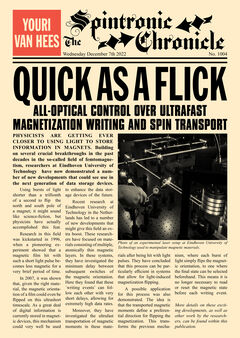Home stretch | Ultrafast writing with light
Because of the ever-increasing growth of our data consumption, researchers are looking for faster, more efficient and more energy-conscious data storage techniques. TU/e researcher Youri van Hees uses ultrashort light pulses that enable him to write information. This way, he combines the advantages of light and magnetic storage.
His thesis looks like an old-fashioned British tabloid. The large headline of a playful article in the Spintronic Chronicle about femtomagnetism, photonics and spin transport reads ‘Quick as Flick.’ A smart way to create some enthusiasm among a wider audience for complicated matters of technology? “More of a nice extra,” says Youri van Hees, who defends his thesis at the department of Applied Physics this week. Apart from a researcher down to the last nanometer, he’s also a passionate music lover and longtime fan of progressive rock band Jethro Tull. “My favorite album, Thick as a Brick, was released exactly fifty years ago. The cover of my thesis is a reference to their album, which came wrapped in a satirical edition of a non-existent local newspaper. Nevertheless, it was quite instructive to write about my research in a way that was appealing to non-physicists. Only then do you realize how inextricably linked you’ve become to certain technology.”
Perhaps it’s the cover of his thesis that will draw the most attention, but its content is equally interesting. Van Hees spent the past four years working on so-called femtosecond lasers, small mirrors and thin magnetic layers. And successfully so, because his research his brought the technology of writing information on a magnetic medium with the use of light one step closer. This is important to data centers, because they would like to start using light as the most energy-efficient means of information transmission. Van Hees: “People have been using magnets to store data for a long time now. This is done in the form of bits – the familiar zeros and ones –, which are like tiny magnetic domains with a north and a south pole. In order to write data, those poles need to switch. We now make those poles shift by creating a magnetic field. Your laptop’s hard disk, for example, contains a small coil with which you can write small magnetic domains. Until now, we always needed an electronic intermediate step for that, because that coil needs to be actuated. That process costs extra time and energy.”
Nano-sandwich
When he shot an ultrashort laser pulse – “even smaller than one billionth of a second” – at magnetic material, Van Hees didn’t just notice something happening locally, but he also realized that the pulse was able to move electrons, which carry magnetic information. He lined up few short light pulses like rail wagons and used this setup to influence the magnetic materials with various small mirrors. “These ultrafast light pulses allowed us to shift the north and south poles of the magnetic domains, which made it possible to skip the electronic intermediate step. It’s also possible now to know with certainty in advance whether you’ll write a ‘0’ or a ‘1,’ without having to know the bit’s initial state. That makes it even more efficient. We also investigated which magnetic materials we need to use to make the bits stable with this new light method. We can’t use the standard sandwich formula of layers of cobalt and gadolinium for stable data storage. However, it turns out that an extra atomic layer of the ferromagnetic metal terbium works really well. We are still looking for the right balance though. Because even though we have stable bits now, the magnetization switching is not as efficient as we would like.”
Broken mirror
Does all this mean that we can expect a photonic data storage breakthrough any time soon? Van Hees says that the technology of writing data with light at lab level is becoming mainstream, and that the chip industry is following this kind of research closely. But, he adds with a smile: “The size of our current laser pulse generator is 60x30x30 cm. It will take some time before it can fit in your pocket.”
There’s a short message on his news cover’s back page, on the right beneath the non-collinear puzzle, which illustrates the fact that minimization can sometimes be a rough business. A true story, Van Hees says. “We had ordered a special mirror for our setup, but it was too large and didn’t fit. Physics sometimes get frustrated too, so what do you come up with? Together with a colleague, I went to work on the mirror with a screw driver. We managed to make it smaller allright, but we couldn’t exactly use it any more either.”



Discussion